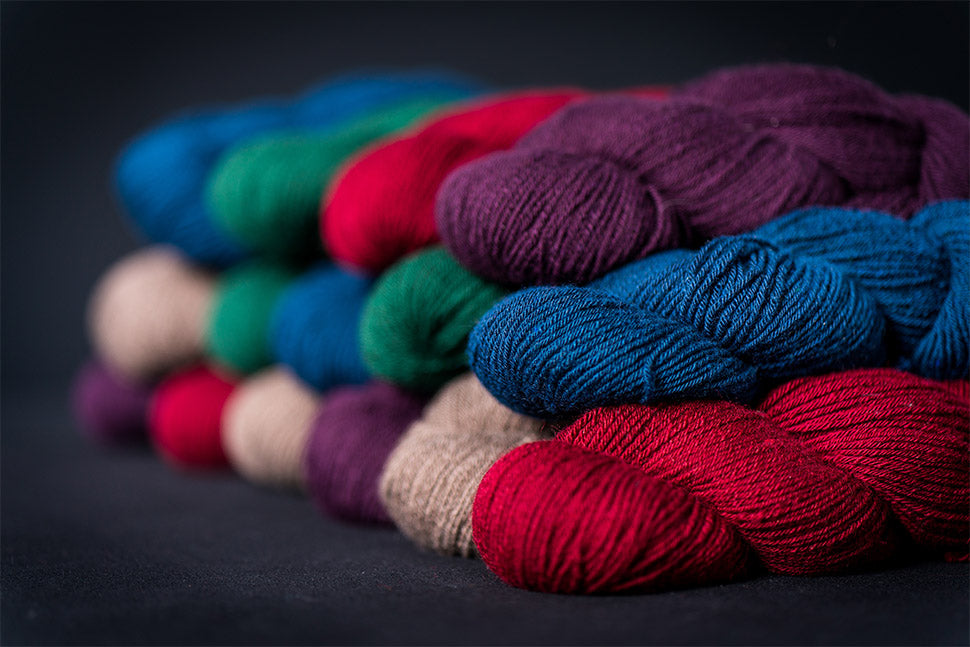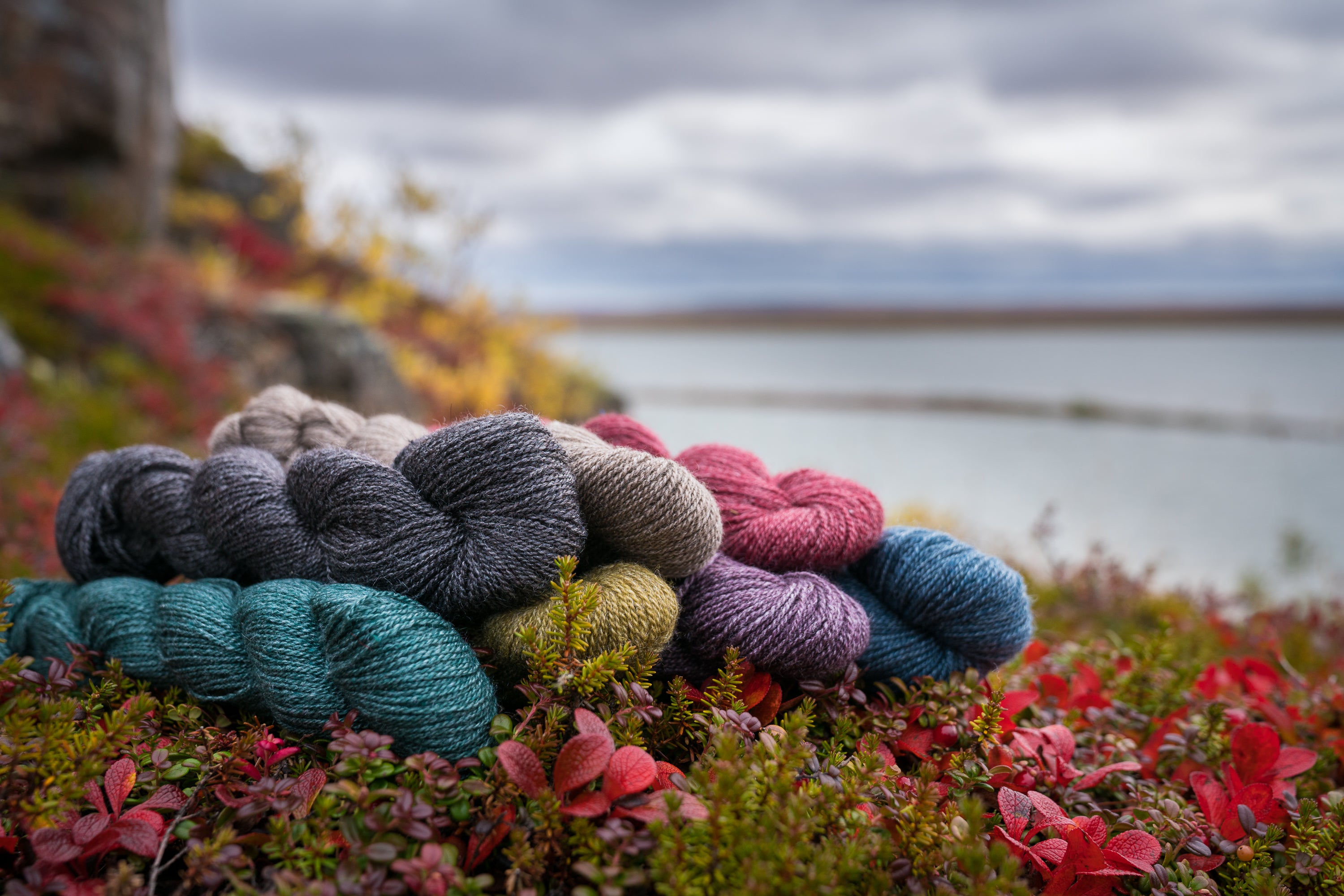Nunavut Qiviut Yarn
QIVIUT YARN PRODUCTS
Nunavut Qiviut spins yarn from muskox, Arctic fox, and Arctic hare qiviut while experimenting with other unique Arctic fibres. All Arctic fibre supplies are locally sourced and support the traditional lifestyles of the Kugluktuk community. Most yarns listed below are a 2-ply lace, in 1 oz. skeins of approximately 190 yards per ounce. We also make a 3 ply, 2 oz, 267 yards pure Muskox Qiviut Yarn and keep small amounts of it. We also have prime dehaired qiviut available for hand spinners. In the past we produced a 3 ply sock yarn.
All of Nunavut Qiviut yarns are gently processed using artisanal small-scale fibre mills. Our blend yarns are hand-mixed at the carder, and we only use certified organic dyes. Nunavut Qiviut avoids over-processing our precious fibre to share the uniqueness and joy of the Arctic in our products.
MUSKOX QIVIUT LACE YARNS
100% Qiviut Lace Yarn – 100% Qiviut Lace Yarn represents all the best qualities of this magnificent fibre – light, sensuous, and luxuriously soft. 100% Qiviut Lace yarn does not have elasticity like wool and has low abrasive resistance. Don’t waste this rare pure fibre on heels and elbows. 100% Qiviut Lace Yarn is used for knitting accessories such as scarves and cowls. Nunavut Qiviut has 100% prime dehaired qiviut for hand spinners.
Pure qiviut has a light chocolate-brown colour. It is a dark fibre, and dyes darker than the natural base colour. It accepts natural non-metal dyes in deep jewel tones, such as purple, indigo, ruby, moss, blue-green, and midnight colours. It is not possible to produce 100% qiviut yarn in lighter tone colours unless harmful bleaching or metal-based dyes are used, or it is blended with lighter colour fibres. Qiviut in light blue, yellow, or other light tones, is probably not 100% or the fibre has been damaged with bleaches or contains metal-based dyes and the supplier should be questioned!

50/40/10 Qiviut Lace Yarn – This qiviut yarn is made of 50% qiviut, 40% superfine merino and 10% silk. The characteristic qualities of qiviut remain dominant in this blend, but the elasticity of superfine merino is added, along with the strength of silk. Superfine merino and silk are both a light tone, which brightens the base colour of the blend compared to 100% Qiviut Yarn. This blend has the same colours as the 100% Qiviut Lace Yarn, but it is a shade lighter. We also have a teal colour that cannot be made in the 100% qiviut yarn because of the darker starting colour. The 50/40/10% blend is more durable and is often knit into accessories that require fibre memory such as hats, headbands, gloves, and fingerless gloves. An elder in Kugluktuk makes beautiful lace gloves from this blend.

50/50 Qiviut Lace Yarn – This qiviut yarn blend is made from 50% qiviut and 50% silk. In 2018, based on our spinning mills recommendation, Nunavut Qiviut hand-blended equal amounts of pure undyed silk and pure qiviut in either natural or dyed colours. The outcome was a lighter palette of yarn compared to the 50/40/10 Qiviut Yarn with a metallic shimmer. The softness of the qiviut comes through in this yarn and adopts the drape of silk. Nunavut Qiviut is very impressed with the results of knitting the 50/50 Qiviut Yarn into shawls and scarves.
Buyers of our yarn might wonder why 50/50 Qiviut Lace Yarn cost more than half than the cost of 100% Qiviut Lace Yarn. The reason is because the 50% Qiviut Lace Yarn includes new expenses such as the cost of silk and the cost of blending the fibres before they are spun into yarn.

MUSKOX QIVIUT DK YARN
30/60/10 Qiviut/Superfine Merino/Silk DK Yarn – This DK or #4 qiviut yarn blend is made from 30% qiviut, 60% superfine merino and 10% silk. In 2020, based on customer requests, Nunavut Qiviut began experimenting with making a thicker qiviut yarn. It is made in a 2 ounce skein and is 150 yards per skein. This 30/60/10 qiviut blend maintains the feel and halo of qiviut and is an economic yarn on a per ounce basis compared to yarns with a higher composition of qiviut. The lower blend ratio of qiviut in the blend also allows for a broader range of dyeing opportunities. We started in late 2021 with 10 colours and in 2022 added 9 more colours for a total of 19. We chose from pastel to dark colours for the 19 available. Arctic Fox yarn is also available in a DK format. Nunavut Qiviut DK qiviut yarn is suitable to a diversity of knit and crochet projects.


ARCTIC FOX QIVIUT LACE YARN
Nunavut Qiviut began experimenting with Arctic fox qiviut in yarns in 2016 and by 2018 released its first Arctic fox yarn. It is a 30% Arctic fox qiviut, 60% superfine merino, and 10% silk blend. This blend behaves as a superfine merino lace yarn. The colour of Arctic fox qiviut is a very light grey, and when blended with superfine merino and silk, the result is an almost pure white yarn with a light-grey tint. Nunavut Qiviut has experimented with dyeing this yarn, but the natural white colour has been very popular, so we have not made commercial quantities of dyed Arctic fox yarn yet. Some knitting customers have made beautiful patterns of hats with the Arctic fox (or Arctic hare) yarn on its own or as an accent colour with the muskox qiviut yarns as the base yarn. This is a very durable yarn that knits like superfine merino and because it has a white starting colour it accepts dyes well. It is perfect for home dyeing projects.
Based on the success of the Arctic Fox Yarn offering, in 2021 we also developed the same yarn blend in a DK or #4 yarn format.
Muskox and Arctic Hare are harvested by Inuit for food. Wild Arctic Fox are humanely harvested by Inuit with quick kill traps and they are used for their fur, as has been done for centuries. Arctic Fox have the largest litter size of any canine in the world. Arctic Fox populations are highly variable; they explode at the peak of lemming cycles, and then they suffer mass starvations when food sources crash. Arctic Fox populations must be carefully monitored near towns because like other small southern predatory mammals like racoons, bats, and skunks, Arctic Fox can occasionally contract the rabies virus and can carry it into Arctic towns where dogs and people can be put at risk. Sustainable and humane Arctic Fox trapping practices help monitor and manage Arctic Fox populations near Arctic communities.

ARCTIC HARE QIVIUT LACE YARNS
Nunavut Qiviut began experimenting with Arctic hare qiviut yarns in 2017. It is debateable whether or not Arctic Hare have qiviut because they are not dual-coated; instead, the animal is covered with a uniformly alabaster white coat of ultra-soft fluffy fur. Nunavut Qiviut calls the fur Arctic Hare qiviut because the fibre is as fine and as soft as muskox and Arctic fox qiviut. Amazingly, Arctic Hare has no winter fat reserves and relies solely on fur for insulation. Traditional Inuit knowledge is that if one tries to live on Arctic Hare protein alone, starvation will follow due to a lack of fat. People with a diet of Arctic Hare must supplement the diet with fat or risk survival.
Arctic Hare Qiviut Yarn is 30% Arctic hare, 50% superfine merino, and 20% silk blend. This blend behaves like a superfine merino lace yarn. Arctic Hare qiviut is pure white, so it is an even whiter, brighter colour than the Arctic Fox yarn. It must be compared side by side to appreciate the whiteness of the Arctic Hare Yarn. Arctic Hare Qiviut Lace Yarn knits and dyes the same as Arctic Fox Qiviut Lace Yarn.
Nunavut Qiviut Dyes
Pure muskox qiviut dyes into deep jewel tones because it has a natural brown colour. Nunavut Qiviut does not bleach or de-pigment its valuable pure muskox qiviut to obtain brighter colours, because this can damage or weaken fibres. Blends with superfine merino and silk allow for lighter tones while maintaining the qiviut fibre quality. Nunavut Qiviut uses Greener Shades dyes which are metal-free and organically certified.
We have experimented with dying our Arctic Fox and Arctic Hare Qiviut Lace Yarn and both accept any colours very well. There is so much demand for the natural white colour that we do not produce dyed yarns except for custom orders.
